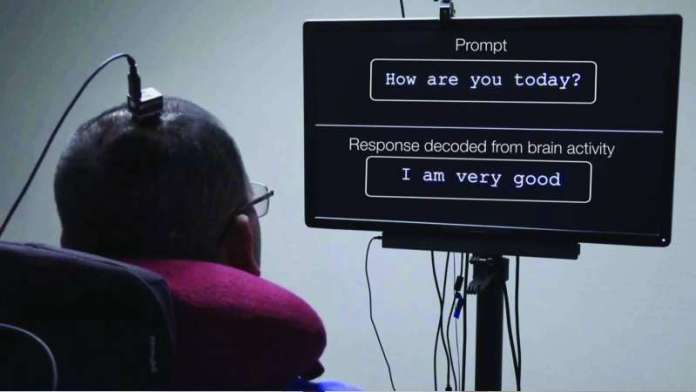Latest News
- Fire Brigade Successfully Contains House Fire In Sulaibikhat
- Kuwait Authorities Refer Kuwaiti Citizen And Expatriate To Narco...
- Kuwait Mourns The Passing Of Esteemed Linguist And Educator Hamz...
- Ministry Of Education Introduces Teacher Licensing Requirement F...
- General Traffic Department Approves 29 Insurance Companies For C...
- Kuwait To Implement New Work Visa And Transfer Regulations In Ju...
- New 24/7 News Channel To Launch In July, Announced By Ministry O...
- Kuwaiti Dentists Make Up 85% Of Those Working In The Public Sect...
- The Royal And His Accomplices Were Remanded To Police Custody Fo...
- Egyptian Victim Of Bank Card Theft
- Electricity Disconnected From Seven Homes For Housing Expatriate...
- Amend Your Status Or Leave Kuwait
Brain Waves Are Translated Into Actual Phrases By A Neuro-compensation Device

According to US researchers, a paralyzed man who is unable to speak or type letters has been able to convey more than a thousand words using a neuro-compensation device that translates his brain waves into phrases.
In the study, which has been published in the journal Nature Communications, the patient's favorite line was, "Nothing is impossible," said Sean Metzger, first author of the study.
In a study last year, scientists at this American university demonstrated that the brain-computer interface was capable of expressing fifty common words that people were trying to pronounce in spoken language.
The new study shows that the interface is able to decipher the 26 letters of the global verbal alphabet that men silently pronounce.
To explain how this mechanism works, Metzger explained to AFP that he used to pronounce (Charlie - Alpha - Tango)" (which are the words used to denote these three letters).
As the sequence of characters is spoken, the interface uses a system that models language in real time to identify words or errors.
The researchers decoded more than 1,150 words, which represents "more than 85 percent of the usual English sentence content."
According to Metzger, this vocabulary set could expand to more than 9,000 words, "the number of words the average person uses in a year."
With an error rate of 6 percent, or nearly seven words per minute, the interface decoded 29 characters per minute.
Metzger believes that this speed could be even higher in the future if the interface is able to understand the alphabet of less frequently used words in addition to 50 common words.
The participant was named "BRAVO1", based on the name of the interface (Brain-Computer Interface Restoration of Arm and Voice Trial).
A patient in his thirties had been attacked at the age of twenty, resulting in a speech disorder called anarthrosis, which makes a person's speech unintelligible while his cognitive abilities remain intact.
A stylus attached to a baseball cap allows him to point his head at the letters on the screen to communicate with others.
The researchers implanted a high-density electrode into his brain in 2019, above the motor cortex that controls speech. When the patient attempts to speak, they monitor the electrical impulses generated there.
The patient (BRAVO1) appreciated the ease of communication with us and said he really enjoyed the experience.
When he asked the patient what they were thinking, he learned a lot about it. For example, “He didn’t like the food at all where he lived.”
Stanford University researchers found that when participants imagined writing sentences, the brain-computer interface could decode 18 words per minute.
However, Metzger believes the best solution is to combine letter detection with phonetic and verbal alphabets.
Thousands of patients lose their ability to speak every year due to stroke, accident, or disease, and the results of the trial must be confirmed by other participants.
Professor Patrick DeGeneres of Newcastle University in Britain praised the "very impressive results".
According to Agence France-Presse, Dr. DeGignard indicated that such a device will only be suitable for use on a very small number of patients in the near future due to its "strongly invasive nature and high risks."
Get The Latest and important news on our Telegram Channel click here to join
Trending News
-
 Ministry Systems Hacked, Electricity Bills Altered
11 May 2024
Ministry Systems Hacked, Electricity Bills Altered
11 May 2024 -
 Kuwait Unveils Monumental Solar Energy Project For...
06 May 2024
Kuwait Unveils Monumental Solar Energy Project For...
06 May 2024 -
 Eid Al-Adha Holiday In Kuwait: Potential 9-Day Bre...
15 May 2024
Eid Al-Adha Holiday In Kuwait: Potential 9-Day Bre...
15 May 2024 -
 Team To Inspect New Airport's Solar Panel Installa...
12 May 2024
Team To Inspect New Airport's Solar Panel Installa...
12 May 2024 -
 Expatriates Caught On Video Stealing Electricity W...
11 May 2024
Expatriates Caught On Video Stealing Electricity W...
11 May 2024 -
 Issuing Work Permits Based On Academic Certificate...
07 May 2024
Issuing Work Permits Based On Academic Certificate...
07 May 2024 -
 Kuwait Terminated 10,000 Expats Over 5 Years
15 May 2024
Kuwait Terminated 10,000 Expats Over 5 Years
15 May 2024 -
 Whatsapp New Updates Announced To Enhance Privacy...
14 May 2024
Whatsapp New Updates Announced To Enhance Privacy...
14 May 2024 -
 Ministry Of Interior Extends Biometric Fingerprint...
14 May 2024
Ministry Of Interior Extends Biometric Fingerprint...
14 May 2024 -
 MoH Updates Employee Working Hours
13 May 2024
MoH Updates Employee Working Hours
13 May 2024










Comments Post Comment